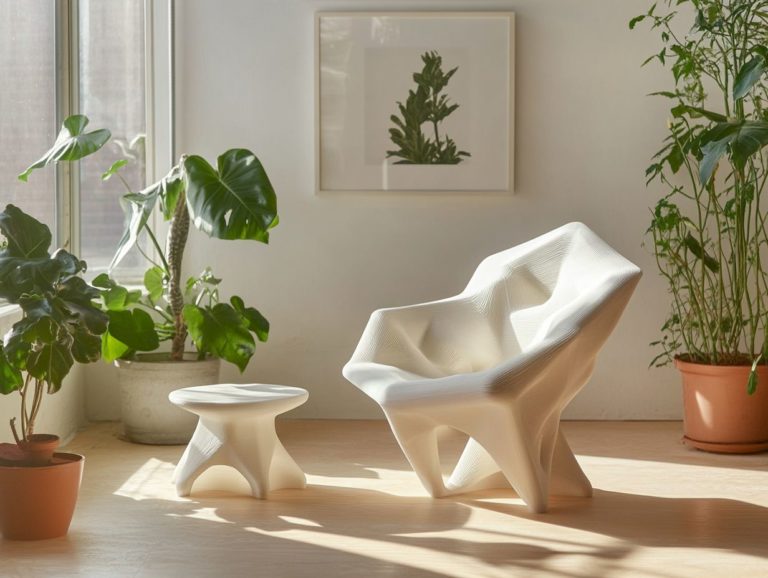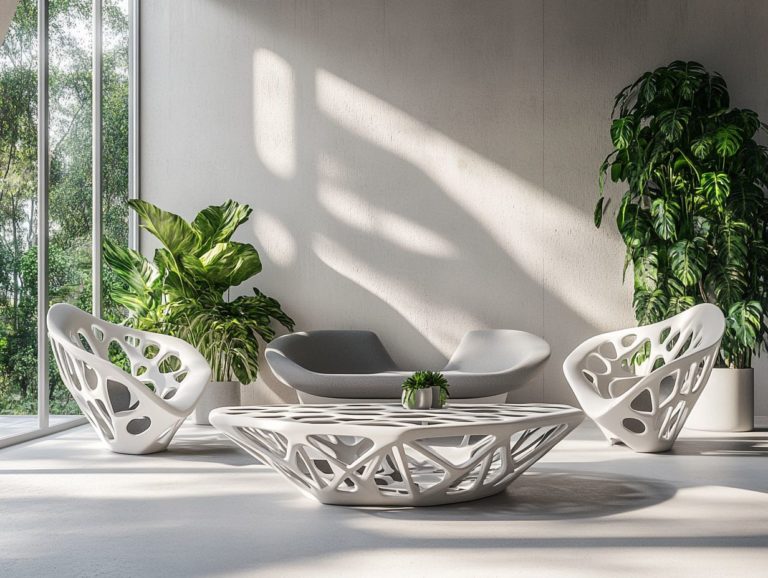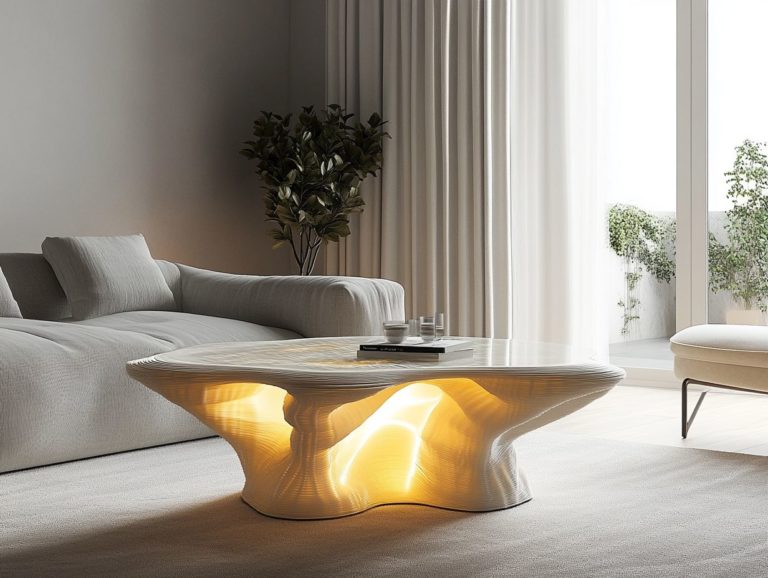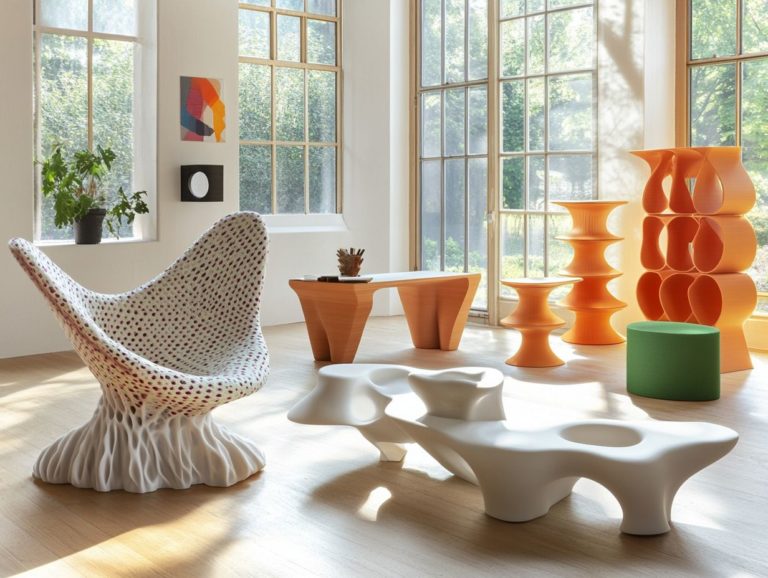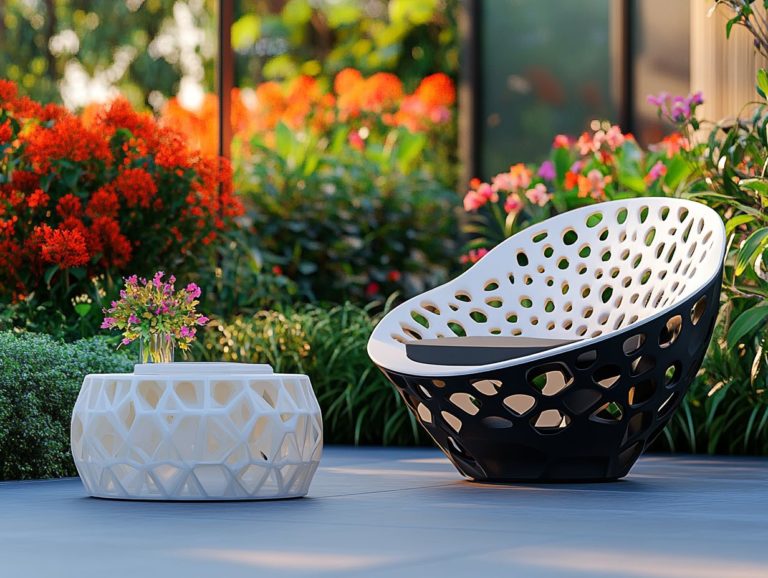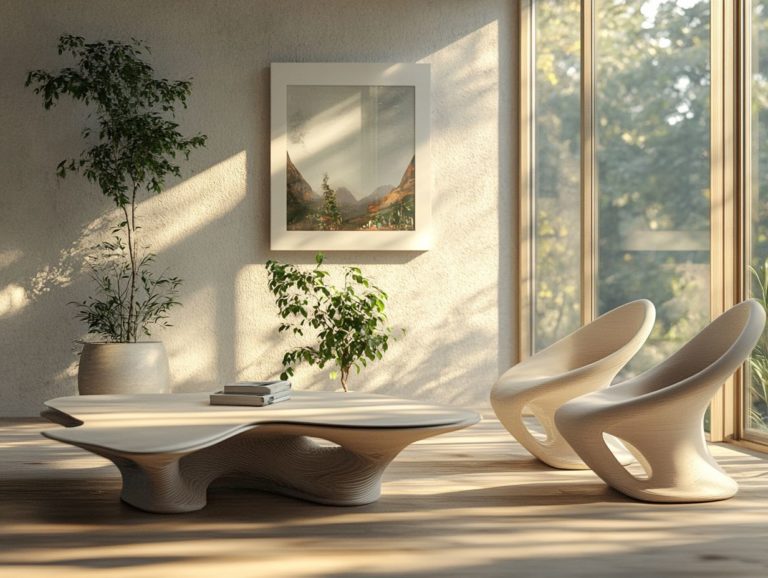3D-Printed Furniture for Home Offices: Top Picks
In a world where flexibility and innovation shape our work environments, imagine a world where your furniture is uniquely yours! 3D-printed furniture stands out as a true game-changer for your home office.
This trend offers fantastic customization, sustainability, and modern design, enhancing not only the aesthetics of your space but also your productivity.
This article delves into the myriad advantages of 3D-printed furniture, what to keep in mind when selecting pieces for your home office, and the top recommendations that seamlessly blend form with function.
Embark on this journey with us as we explore the future of furniture and uncover how it can elevate your workspace.
Contents
- Key Takeaways:
- 1. Advantages of 3D-Printed Furniture
- 2. Factors to Consider When Choosing 3D-Printed Furniture for Home Offices
- 3. Top 3D-Printed Furniture Picks for Home Offices
- What Materials Are Used in 3D-Printed Furniture?
- How Durable Is 3D-Printed Furniture?
- What Are the Design Options for 3D-Printed Furniture?
- How Much Does 3D-Printed Furniture Cost?
- What Are the Environmental Benefits of 3D-Printed Furniture?
- Can 3D-Printed Furniture Be Customized?
- What Are the Potential Downsides of 3D-Printed Furniture?
- How Does 3D Printing Technology Work for Furniture?
- What Are the Latest Innovations in 3D-Printed Furniture?
- How Can 3D-Printed Furniture Improve Productivity in Home Offices?
- What Are the Future Possibilities for 3D-Printed Furniture?
- What Are the Safety Considerations for 3D-Printed Furniture?
- How Can One Maintain and Care for 3D-Printed Furniture?
- What Are the Customer Reviews and Ratings for Top 3D-Printed Furniture Picks?
- How Can One Purchase 3D-Printed Furniture for Home Offices?
- What Are the Return and Warranty Policies for 3D-Printed Furniture?
- Frequently Asked Questions
- 1. What is 3D-printed furniture and why is it a favorite for home offices?
- 2. What are popular 3D-printed furniture options for home offices?
- 3. Can I customize 3D-printed furniture to fit my needs?
- 4. Is 3D-printed furniture durable for daily use?
- 5. How does the cost of 3D-printed furniture compare to traditional options?
- 6. Is 3D-printed furniture environmentally friendly?
Key Takeaways:
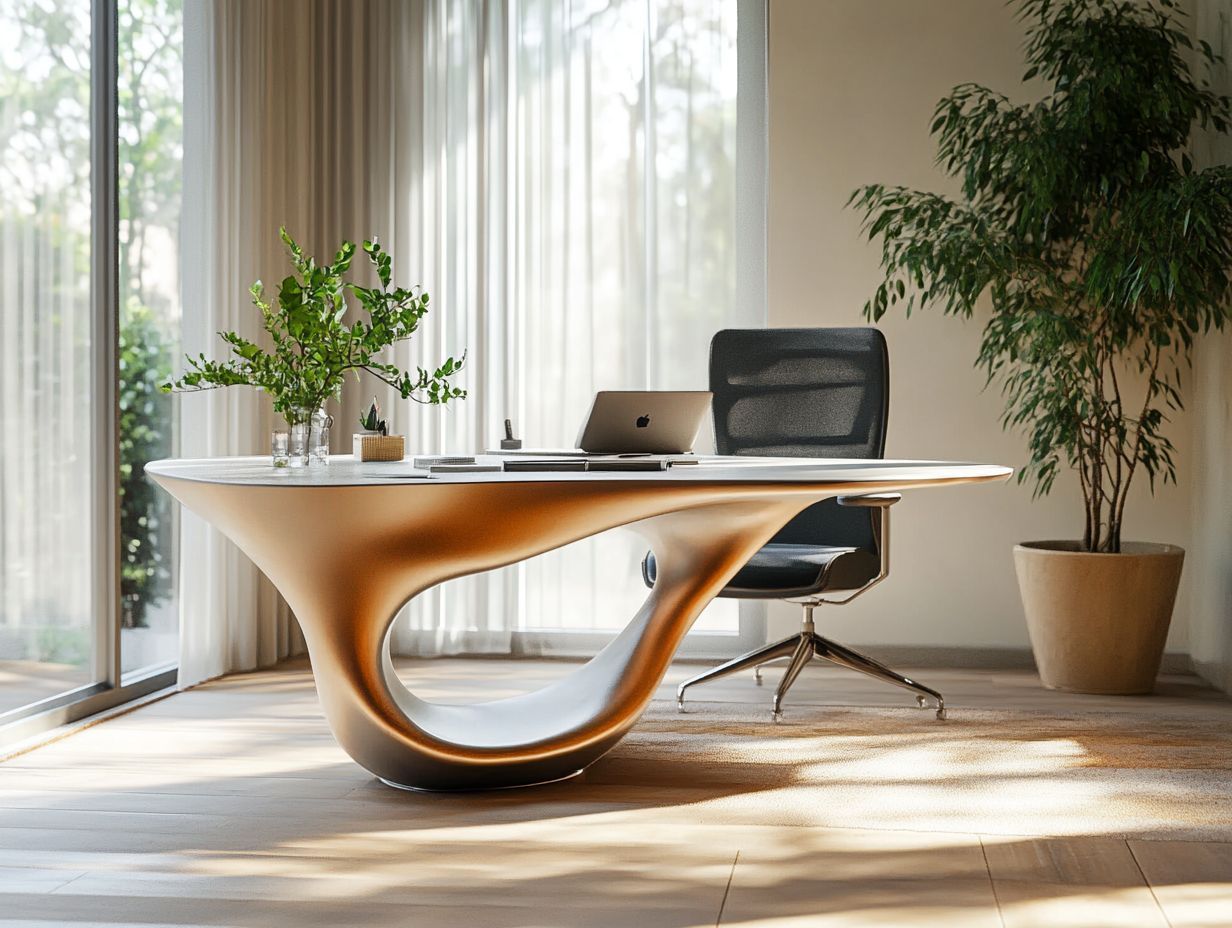
- 3D-printed furniture offers numerous advantages, including cost-effectiveness, customization options, and environmental benefits.
- When choosing 3D-printed furniture for home offices, consider materials, durability, design, cost, and potential downsides.
- Top 3D-printed furniture picks for home offices include ergonomic chairs, adjustable desks, and storage solutions.
1. Advantages of 3D-Printed Furniture
3D-printed furniture signifies a transformative leap in the furniture industry. Innovative technologies blend sustainable materials with digital production methods.
This fusion allows for unparalleled creative expression and unique shapes that traditional craftsmanship often struggles to achieve. This advancement promotes eco-friendly practices and minimizes production waste.
It enhances design optimizations, making it an enticing option for consumers like you who seek both functionality and aesthetics in home furnishings.
The flexibility of 3D printing gives the power to designers to explore intricate textures and forms. This results in highly personalized pieces that resonate with your individual style and preferences.
Customization options let you select colors, shapes, and sizes tailored to your specific needs, ultimately enhancing your experience.
Sustainable materials like PLA (polylactic acid), a biodegradable plastic made from natural materials like corn, ensure that the furniture you choose is less harmful to the environment.
Notable fashion brands and designers, including Philippe Starck and Studio North, have embraced 3D printing in their design processes. They craft stunning, eco-friendly furniture that fulfills practical functions and makes a striking aesthetic statement.
2. Factors to Consider When Choosing 3D-Printed Furniture for Home Offices
When selecting 3D-printed furniture for your home office, it’s crucial to consider ergonomic design, durability, and how well the pieces align with contemporary design trends. Exploring stylish 3D-printed furniture solutions can also inspire your choices.
This ensures your workspace is not only functional but also visually appealing. A thoughtfully designed workspace can significantly boost your productivity while nurturing creativity and comfort.
Making ergonomic design an essential priority is vital. The materials used in 3D printing play a crucial role in determining the longevity of these pieces, providing robust options that can withstand daily use.
You should also seek items that integrate seamlessly with your ongoing improvement projects, blending functionality with style. As design trends continue to evolve, the rise of 3D-printed functional art and unique aesthetics is transforming how you furnish your spaces.
This invites novelty and personalization into your environment.
3. Top 3D-Printed Furniture Picks for Home Offices
Explore the top 3D-printed furniture options for your home office. From stylish desks to innovative lighting designs, these pieces marry functionality with modern aesthetics. If you’re looking for guidance, check out how to choose the right 3D-printed furniture for your home, ensuring your workspace is inspiring and efficient.
These selections showcase the latest 3D printing technology and imaginative designs tailored to suit various personal tastes and work requirements. For example, Zaha Hadid Architects has crafted fluid, organic-shaped desks that introduce a sculptural presence to any room. Meanwhile, Roche Bobois offers customizable modular shelving solutions that maximize your space effectively, much like the top 10 innovative 3D-printed furniture pieces available today.
Many of these pieces incorporate sustainable materials, reflecting a commitment to eco-friendliness. You can enhance your work environment without sacrificing style or ethics. This remarkable fusion of innovation and design redefines what your home office can be.
What Materials Are Used in 3D-Printed Furniture?
3D-printed furniture is crafted from a variety of sustainable materials, including PLA (polylactic acid), recycled materials, and biodegradable options. This amplifies the environmental benefits of digital manufacturing and opens the door to innovative design possibilities.
Each material brings unique properties that impact the aesthetics and durability of the final product. For instance, PLA provides a glossy finish and vibrant colors, making it a favorite for eye-catching designs. In contrast, recycled plastics offer a distinctive, textured look that tells a story of its origins. Nylon adds strength to your furniture, meeting functional needs without compromising style.
Choosing eco-friendly materials is essential for a sustainable future. By opting for sustainable options, you support responsible practices and inspire architects and designers to rethink traditional manufacturing methods, paving the way for a greener future.
How Durable Is 3D-Printed Furniture?
The durability of 3D-printed furniture depends on the materials you choose and the structural optimization techniques applied during production. This means using specific methods to ensure the furniture is sturdy, making these pieces functional art and resilient investments that withstand the test of time.
The materials available vary widely, from robust thermoplastics to sustainable composites, influencing not just strength but also longevity. When you employ careful layering techniques during the printing process, you enhance structural integrity, allowing the furniture to resist wear and tear from daily use.
Another vital consideration is the management of production waste. Minimizing waste improves the overall quality of your pieces by reducing weak spots and imperfections. By investing in high-quality materials and conscientious production practices, you create furniture that is not only visually stunning but also durable enough for everyday living.
What Are the Design Options for 3D-Printed Furniture?
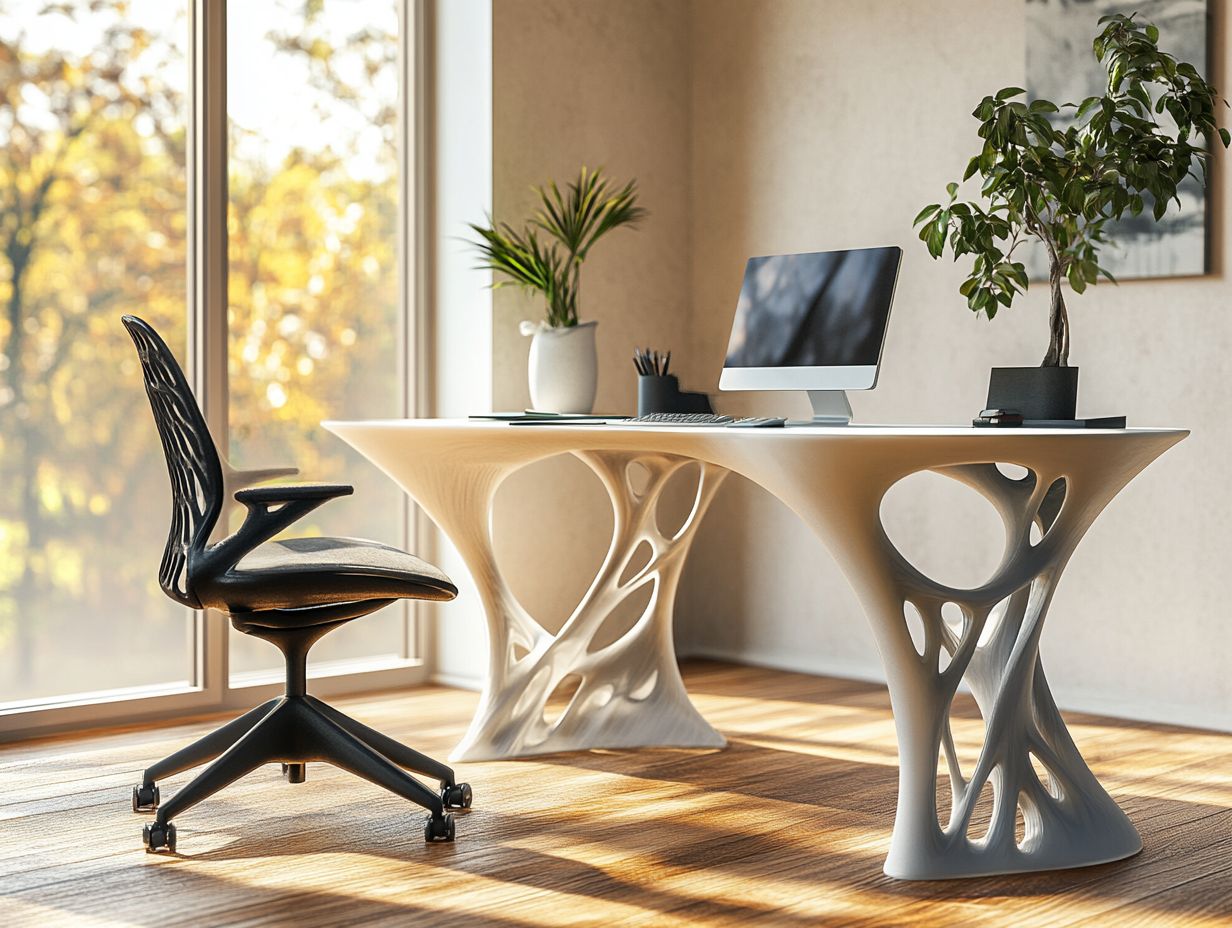
3D-printed furniture offers an abundance of design possibilities, enabling unique shapes and forms that traditional furniture making cannot achieve. For minimalists, there are 5 modern 3D-printed furniture pieces that open the door to unparalleled creative expression in furniture design.
By harnessing advanced printing techniques, you can explore intricate patterns and complex geometries that challenge conventional aesthetics. The ability to customize components gives you the power to craft pieces tailored to your preferences or specific functionalities.
This adaptability ushers in a new era of innovation, where materials can be manipulated in ways previously thought impossible. This leads to sustainable solutions that resonate with your modern values. Ultimately, this flexibility transforms how furniture is made and redefines what furniture can be, elevating your everyday spaces into showcases of artistic ingenuity.
How Much Does 3D-Printed Furniture Cost?
The cost of 3D-printed furniture can vary significantly. It is influenced by factors such as the materials used, production techniques, and the complexity of the design. It s crucial to consider these elements when budgeting for your home furnishings.
Different pricing tiers reflect the quality and uniqueness of each piece. Options range from more affordable, mass-produced furniture to exquisite, custom designs. Be mindful of potential hidden costs from product testing and personalization, as these can contribute to the overall expense.
When evaluating the value of 3D-printed furniture compared to traditional alternatives, consider not just the price, but also the durability, design versatility, and environmental impact of the materials used.
What Are the Environmental Benefits of 3D-Printed Furniture?
3D-printed furniture offers remarkable environmental advantages by minimizing waste and embracing a design that encourages recycling. This approach greatly enhances sustainable practices within the furniture industry.
By using materials more efficiently, you can reduce excess and scrap. You also have access to eco-friendly options like biodegradable plastics (which break down naturally) and recycled composites (made from repurposed materials). This sustainable model allows manufacturers to create pieces that are functional and contribute to environmental preservation.
Circular design practices emphasize the importance of crafting products that can be easily repaired, repurposed, or recycled at the end of their lifecycle. This helps us reuse materials effectively instead of discarding them in landfills.
Can 3D-Printed Furniture Be Customized?
One standout feature of 3D-printed furniture is its extensive customization options. As a designer or consumer, you can collaborate to create unique textures and shapes that cater to your individual needs and preferences.
This innovative process offers a vast array of choices. You can select specific colors that harmonize with your decor or choose materials that provide varying degrees of durability and comfort. For instance, if you re a family looking for a playful living room chair, you can work with designers to add vibrant colors and whimsical patterns. If minimalism is your style, you might prefer a sleek design in neutral tones.
Collaborative design projects found in community workshops or online platforms illustrate this capability. Here, you can suggest features and share ideas, resulting in functional pieces that reflect collective creativity and personal stories. Don t miss the chance to create furniture that truly reflects your style!
What Are the Potential Downsides of 3D-Printed Furniture?
While 3D-printed furniture has many advantages, it s important to recognize some potential downsides, such as durability concerns and inconsistent quality from various manufacturers’ methods.
These issues might affect the longevity of your pieces compared to traditional handmade furniture, which often benefits from time-tested materials and expert craftsmanship. The costs of producing 3D-printed items can sometimes be higher than traditional furniture, prompting you to question the value for money.
Though the design possibilities are impressive, certain limitations can arise regarding the complexity and scalability of intricate patterns. To navigate these challenges, focus on brands known for their high-quality production and consider customized options with robust materials, ensuring both durability and aesthetic appeal.
How Does 3D Printing Technology Work for Furniture?
3D printing technology operates through a process called additive manufacturing, a way of building things layer by layer, where your computer-aided designs (CAD) are turned into real items. This innovation is reshaping how furniture is crafted and conceived in today s world.
With specialized software at your fingertips, you can design intricate and customizable pieces that were once deemed impossible to create. This approach promotes precision and allows your creativity to shine, ensuring that every item aligns perfectly with your needs.
For furniture makers like you, the advantages are numerous: reduced waste, lower production costs, and the agility to adapt designs swiftly based on customer preferences are just a few of the perks. As a consumer, you benefit from unique and personalized furnishings, enriching your living space with tailored solutions that truly reflect your individual style and requirements.
What Are the Latest Innovations in 3D-Printed Furniture?
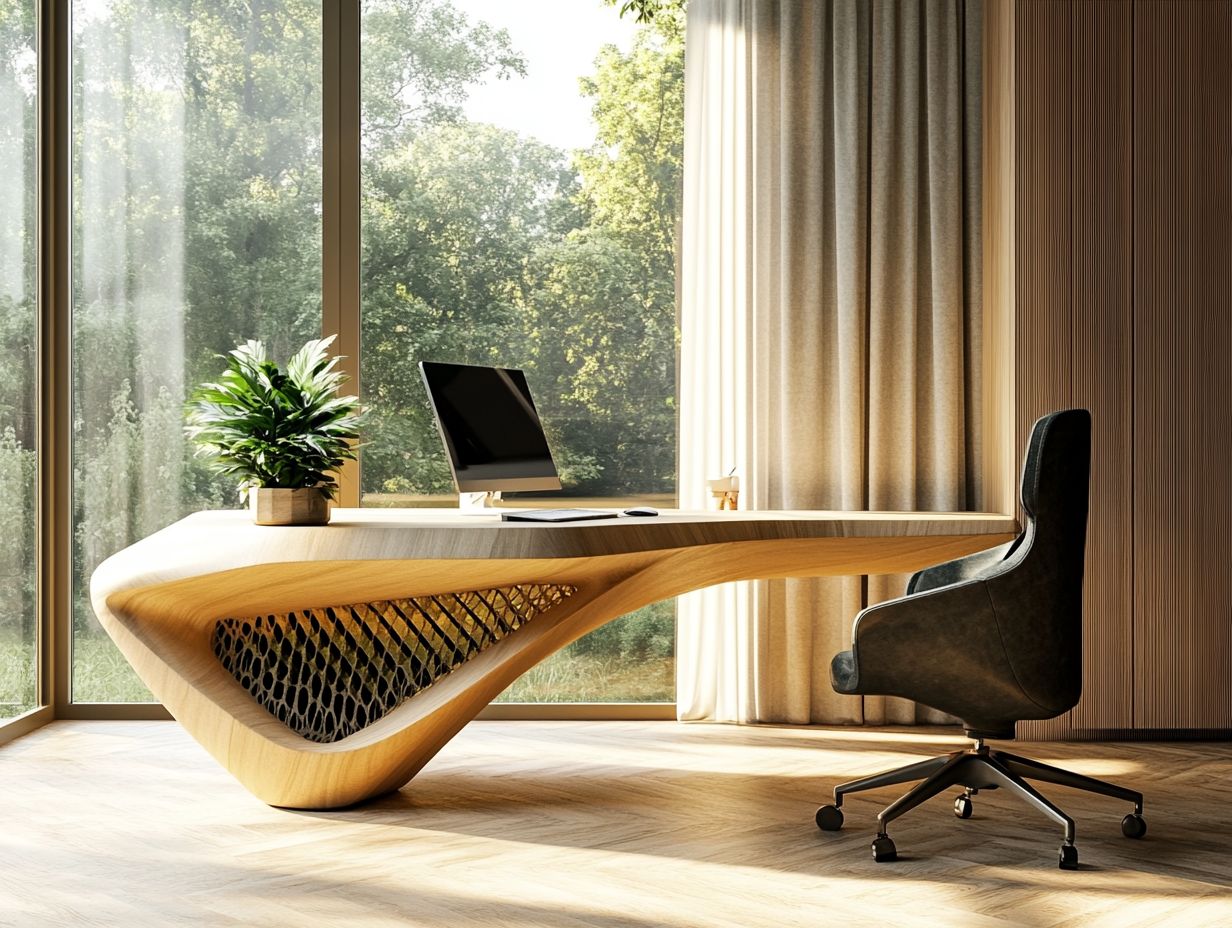
The latest innovations in 3D-printed furniture are propelled by cutting-edge technologies that continuously reshape the industry. These innovations introduce fresh design trends, materials, and manufacturing techniques that expand the very limits of furniture evolution.
Recent advances have unveiled eco-friendly materials, such as biodegradable plastics and recycled composites. These not only elevate the sustainability of the manufacturing process but also enhance durability.
With these materials, designers can craft intricate structures that were once thought impossible, resulting in furniture that is both visually striking and highly functional.
The emergence of customizable 3D printing techniques gives you the power to tailor furniture to meet your specific needs, encouraging a more personalized approach to home design while minimizing waste. As these technologies continue to evolve, they promise to redefine both the aesthetic and practical aspects of modern living spaces, elevating your environment in ways previously unimagined.
How Can 3D-Printed Furniture Improve Productivity in Home Offices?
3D-printed furniture can transform your home office into a productivity powerhouse by offering 5 best 3D-printed furniture solutions for urban living tailored to your unique needs, promoting both comfort and efficiency during those long work hours.
Consider, for example, adjustable desks that allow you to seamlessly transition between sitting and standing. These desks help you feel better, so don t wait to make the switch! Research shows that users of such desks have experienced a remarkable 46% boost in productivity, along with a significant reduction in discomfort.
Likewise, supportive chairs crafted through 3D printing techniques can mold to your body, ensuring you maintain proper posture. Studies indicate that better ergonomic support can lead to a 12% increase in overall productivity, highlighting how thoughtful furniture design enhances workplace efficiency.
By investing in these innovative pieces, you can cultivate an environment where both comfort and performance thrive, allowing you to work smarter and feel better.
What Are the Future Possibilities for 3D-Printed Furniture?
The future possibilities for 3D-printed furniture are truly limitless, with advancements in technology and material science set to revolutionize the furniture industry. These innovations will foster even more creative possibilities and sustainable designs.
Imagine innovative features like smart furniture that seamlessly integrates technology to enhance your experience. Picture a chair that adjusts its firmness based on your posture or a table that wirelessly charges your devices. This isn t just a dream; it s on the horizon.
The development of biodegradable and recyclable materials is gaining traction, responding to your growing demand for eco-friendly options. As sustainability becomes a central pillar of manufacturing, 3D-printed furniture could not only reduce waste but also facilitate localized production, cutting down on carbon footprints and speeding up delivery times.
The future of furniture is not only exciting but also aligns with your values.
What Are the Safety Considerations for 3D-Printed Furniture?
Safety considerations are paramount when it comes to 3D-printed furniture, especially regarding the materials you choose and the product testing procedures that ensure these items meet industry standards for your protection.
The selection of materials profoundly affects both the safety and longevity of these innovative pieces. Manufacturers should prioritize non-toxic, environmentally friendly options whenever possible.
Rigorous product testing is crucial in assessing the structural integrity and durability of 3D-printed items, as well as their resistance to wear and tear over time. By adhering to regulations set by the American National Standards Institute (ANSI) and the International Organization for Standardization (ISO), manufacturers establish a benchmark for quality you can trust, ensuring that your purchases are both stylish and safe.
How Can One Maintain and Care for 3D-Printed Furniture?
Proper maintenance and care of your 3D-printed furniture are essential for its longevity and performance. This involves specific cleaning methods and protective treatments designed to preserve the quality of the materials.
By engaging in this process, you enhance the appearance of your furniture and prevent potential issues over time. Start with gentle cleaning techniques like using a soft cloth and mild soap to remove dust and grime without scratching the surface. Avoid harsh chemicals that might degrade the material.
Consider applying a protective coating specifically designed for 3D-printed surfaces to guard against wear and tear. Keep your furniture away from direct sunlight and extreme temperatures, as these factors are vital for maintaining its top condition.
With these simple yet effective practices, you can enjoy your innovative pieces for years to come.
What Are the Customer Reviews and Ratings for Top 3D-Printed Furniture Picks?
Customer reviews and ratings are essential when evaluating the top picks in 3D-printed furniture. They provide valuable insights into user experiences and product development, giving you the power to make informed decisions.
By diving into customer feedback, you ll find important information about the design, durability, and overall usability of these innovative pieces. Many users rave about the lightweight nature of 3D-printed furniture, making it easy to move and rearrange.
However, some critiques raise concerns about stability and finish quality, prompting manufacturers to address these issues in future iterations. This feedback loop not only enhances product quality but also helps you understand which items align best with your personal needs and aesthetic preferences.
How Can One Purchase 3D-Printed Furniture for Home Offices?
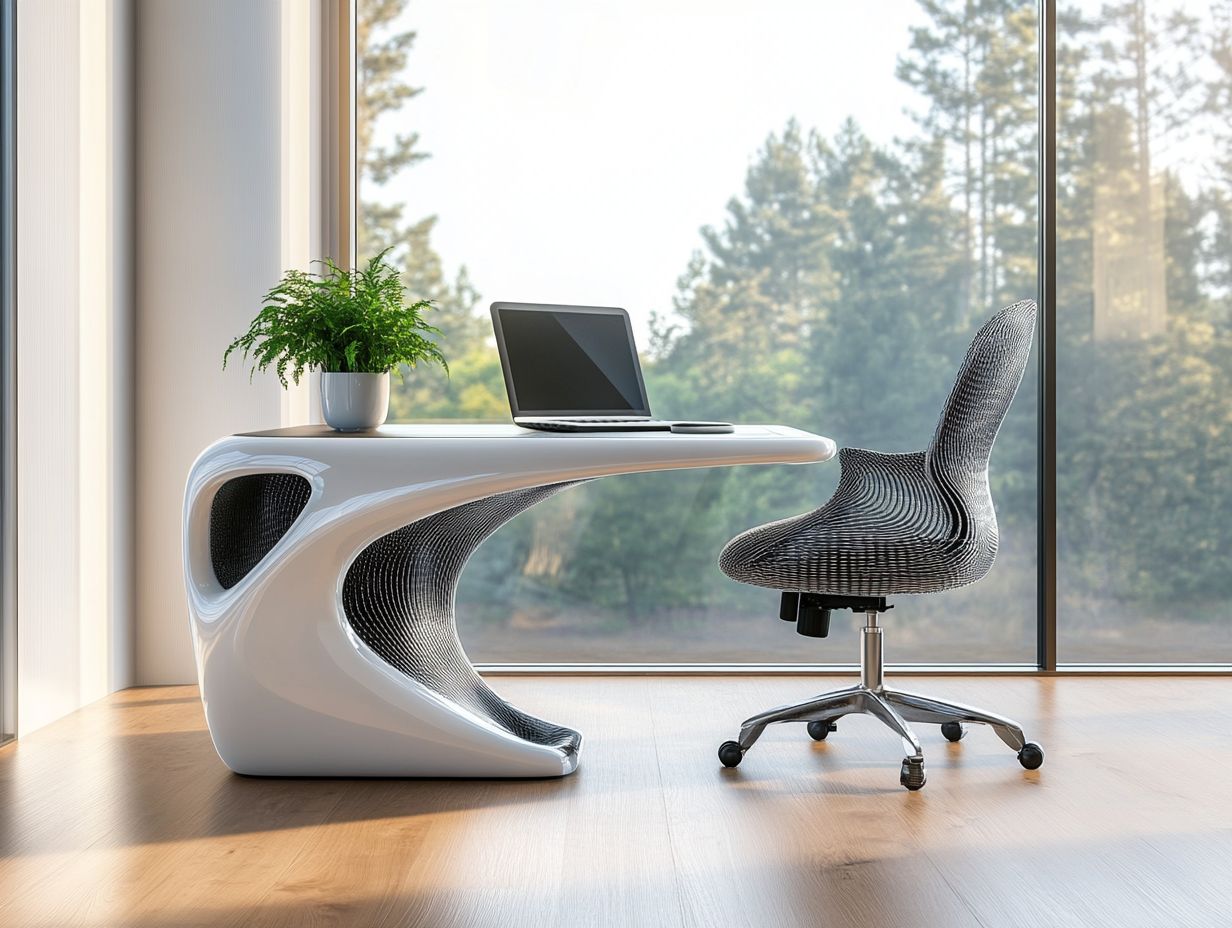
Purchasing 3D-printed furniture for your home office invites you to explore various platforms and retailers, including the best 3D-printed furniture stores online, specializing in innovative collections that ensure the perfect fit for both your workspace and style.
This journey begins with identifying reputable online retailers known for their unique offerings and exceptional customer service, where you can browse an extensive range of designs. Visiting local showrooms allows you to evaluate materials and comfort firsthand.
If you seek a personalized touch, custom orders can provide tailored dimensions or aesthetics, enhancing your overall office environment.
When evaluating potential pieces, consider factors such as ergonomic design, dimensions relative to your space, and how well they harmonize with your existing decor. This thoughtful approach will help you create a productive and visually pleasing workspace.
Don’t miss out on the latest designs that can transform your home office!
What Are the Return and Warranty Policies for 3D-Printed Furniture?
Understanding the return and warranty policies for 3D-printed furniture is essential. These guidelines protect you and ensure your satisfaction.
The new furniture technology is growing rapidly. Knowing these policies helps you avoid potential disappointments.
Many brands offer different terms. This often includes limited guarantees covering manufacturing defects or specific conditions for returns.
Make sure to read these terms carefully before you buy. Keep your receipts and document any product issues.
Don t hesitate to reach out to customer service for clarifications. This approach leads to better resolutions if problems arise.
Frequently Asked Questions
1. What is 3D-printed furniture and why is it a favorite for home offices?
3D-printed furniture is made using a 3D printer, which builds the item layer by layer. This furniture offers unique designs and is often more cost-effective and eco-friendly than traditional options.
2. What are popular 3D-printed furniture options for home offices?
Popular choices include desks, chairs, shelves, and storage solutions. For those looking to optimize space, exploring the best 3D-printed furniture for small living areas can add style to a modern home office.
3. Can I customize 3D-printed furniture to fit my needs?
Absolutely! You can collaborate with designers to create pieces that match your exact specifications for any workspace.
4. Is 3D-printed furniture durable for daily use?
Yes, it is designed to be strong and durable for everyday use. The materials used are robust, making them suitable for frequent use.
5. How does the cost of 3D-printed furniture compare to traditional options?
3D-printed furniture is generally cheaper than traditional furniture. It avoids high material and labor costs.
6. Is 3D-printed furniture environmentally friendly?
Yes, it is considered more sustainable. 3D printing uses less energy and produces less waste than traditional furniture manufacturing.

